Four Pilot Lights
Nothing Could Extinguish their Flames
By Susan Burke
Editor’s Note: This article was first published in the September 2006 issue of Air Line Pilot magazine. Click here to read our 2016 article on 9/11 scholarship recipients.
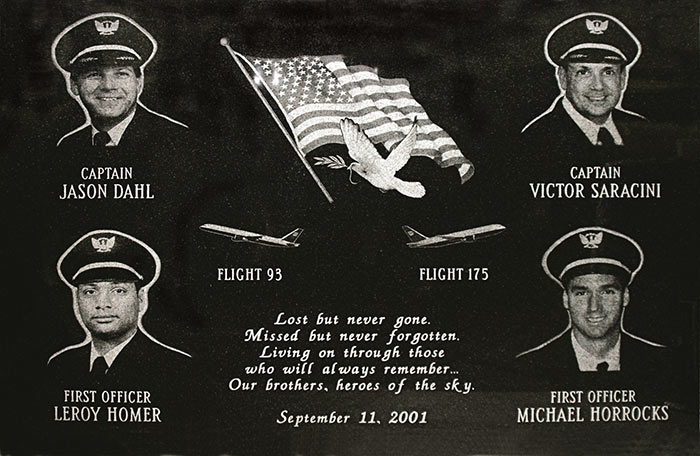
A granite memorial to the four United Airlines pilots lost on 9/11 hangs in the United Airlines Flight Office at New York’s John F. Kennedy International Airport.
Memorials have sprung up all over America during the last five years, but some people don’t need a single brick or stone to remember the laugh, the personality, the dedication and skill, the love and friendship of those who are gone. On Sept. 11, 2001, ALPA lost four of its members— United Airlines pilots who were already larger than life.
Three of them—Capt. Victor Saracini and First Officers Michael Horrocks and LeRoy Homer—were members of New York’s Council 52. The fourth, Capt. Jason Dahl, belonged to Council 34 in San Francisco and had picked up the Flight 93 trip to get time off for an anniversary trip with his wife. The following reminiscences of friends and family show they all remain very much alive in the hearts that loved them.
United Flight 175 (World Trade Center, South Tower, NYC)
Capt. Victor Saracini, 51
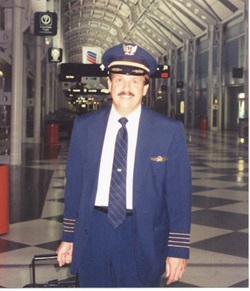 “Vic was a terrific guy,” says Capt. Mark Seal, chairman of Council 52 on 9/11. “He was from South Jersey, with a dry sense of humor and a great family. He was a committed, hard-core union member, the result of going through the strike in 1985 and being one of the 570 [pilots whom United hired to break a strike if it occurred; only 4 of the 570 eventually crossed the picket line].”
“Vic was a terrific guy,” says Capt. Mark Seal, chairman of Council 52 on 9/11. “He was from South Jersey, with a dry sense of humor and a great family. He was a committed, hard-core union member, the result of going through the strike in 1985 and being one of the 570 [pilots whom United hired to break a strike if it occurred; only 4 of the 570 eventually crossed the picket line].”
Capt. Greg Downs, also among the 570 and a close friend, knew Saracini as being “very meticulous about planning for his kids, Kirsten and Brielle, his wife, Ellen—and his mother, Anne. “When he was young, his mother struggled to give him what he needed. So, for fun, he sent her checks for odd amounts like $73.22, every month. And he made sure she was taken care of in case anything happened to him.”
Saracini was a critical thinker, Downs said. “He made sure everything you told him was true, he did his homework. He interviewed five doctors before he let one operate on him. He had knee surgery once, and that morning he wrote in ink on his good knee: ‘wrong knee.’ After the strike, he stayed cynical about our industry and where the piloting profession was headed. In hindsight, his skepticism was warranted; he’d be disappointed, but not surprised.”
That skepticism was tempered by his sense of humor—and by his compassion. “A few years back, my wife’s favorite cat died unexpectedly,” Downs said. “She was pretty upset, so Vic left her a message to cheer her up and said, ‘I’m coming over to take you out to buy you a new cat!’”
Downs, who as Local Air Safety Chairman—and family friend—told Ellen that Vic’s plane had crashed into the second tower, reflected, “He was focused on what he wanted to do—and he was living at a fast pace to make sure he got things done for his family.”
Ask Ellen Saracini about her husband, and the stories come tumbling out: “Vic loved to plant a seed, and then walk away. He didn’t have to be there for the joke, the outcome, the happiness, the confusion. He was a big prankster.” And he knew how to make the most of it. Saracini often spent time with Ellen’s sister and her children when he flew to California, and once he was there on little Erica’s birthday. “Uncle Vic’s coming and it’s my birthday, and we’re going to have a ball,” she announced. Except Uncle Vic didn’t acknowledge the birthday all evening, even though Erica kept “throwing out hints about how old she was getting and how mature she was.”
Finally, they drove him to the hotel, and went home, Ellen said, “and Erica was so depressed. But when she went into her room, she saw that he had taped $1 and $5 bills all over the walls, on her bed, on the floor, on the ceiling.”
He had run back into the house “for one second,” just before leaving for the hotel, ready with the bills and the tape. “And my sister said Erica was running and jumping and pulling the bills off and throwing them up on top of her and rolling in them,” Ellen said. “It was just the best thing ever in the whole wide world!”
Saracini loved and admired Forrest Gump, loved music, loved learning— and he loved mentors. “He always enjoyed being mentored by someone he felt was really a good person,” his wife said. “He would have been a mentor himself.” Years ago, he wrote to Ellen’s nephew, telling Justin, who didn’t have a dad, that he’d always be there for him.
When Justin showed her the letter, after 9/11, “it was all folded up, neat but old, worn out on the edges. The day he got that letter from Victor, he put it in his wallet and never took it out.” And finally, she said, “I used to think I was more ready to go to heaven and meet my Maker than he was— until after he passed away, and then I realized that he was much more ready on a different level.
“That last summer we spent at the beach. We used to get up early and go for walks on the boardwalk. When we came back, we’d get the kids up, I’d start breakfast going, and he’d go out. He had a daily meditation book that he would read, and then he’d do a little meditation. I guess in hindsight he was getting ready for his journey.”
Ellen Saracini is leading the Garden of Reflection project, a memorial park in Bucks County, Pa., which lost 17 residents on 9/11. Visit www.9-11memorialgarden.org.
First Officer Michael Horrocks, 38
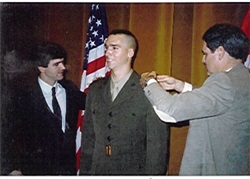 F/O Mike Horrocks “had two kids he adored, Mick and Christa,” says Greg Downs, who flew with Horrocks twice. “One thing that stands out in my mind about Mike is the time we were in Las Vegas. I have an image of him on the phone with his children, smiling ear to ear as we stood in front of Treasure Island, waiting for the pirate ships to attack. When he hung up, he just said, ‘It’s neat to have kids.’”
F/O Mike Horrocks “had two kids he adored, Mick and Christa,” says Greg Downs, who flew with Horrocks twice. “One thing that stands out in my mind about Mike is the time we were in Las Vegas. I have an image of him on the phone with his children, smiling ear to ear as we stood in front of Treasure Island, waiting for the pirate ships to attack. When he hung up, he just said, ‘It’s neat to have kids.’”
Mike Horrocks often volunteered at his children’s elementary school in Media, Pa., and he also “liked to have fun,” Downs said. So it was natural that the family chose the renovation of the school playground as a memorial. Downs describes Horrocks as “a big beach guy who loved boating and fishing. I remember his talking about buying a boat, trying to decide between two motors for fishing or a walk-in closet in a new house. He went with the house.”
Mark Seal had flown with Mike Horrocks only a couple of times, he said, but “I remember him as being a professional pilot—he loved being a United Airlines pilot.”
And he loved flying for the Marine Corps. First Officer Warren Clark (United), who worked with Horrocks when both were T-34 instructors at Whiting Field, wrote of him, “Mike had that charisma that only a true leader can possess … that someone develops after being a leader of men for a long time. [N]othing was more important to Mike than people. It was his code.”
Michael’s brother, Bill, in his memorial service eulogy, said: “He had a genuine appreciation for the small things in life. He turned everything he did into an enjoyable experience, whether it was doing work around the house or doing a crossword puzzle. He was never in a rush and never took risks.”
“His children were his pride and joy. [He] spent more quality time with his kids than most of us can dream of.” “He loved to laugh and to make others laugh. He loved practical jokes….” “Michael had an old soul… . A soul that learned to love the journey, not just the destination.”
Michael’s wife, Miriam, said the pilots’ support has been remarkable: “I can’t begin to tell you how incredible all the pilots were to us during the days, weeks, months, now years that followed Michael’s death. “I know in my heart and soul that Michael and all the other brave people on those airplanes will always be remembered. Thank you to each and every pilot who continues to keep Michael’s memory alive for us all!”
United Flight 93 (Shanksville, Pa.)
Capt. Jason Dahl, 43
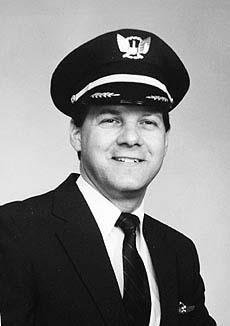 Then–Chief Pilot Tim Adam hired Capt. Jason Dahl as a standards captain in the B-757 fleet at the Denver Training Center back in the late 1990s, and never regretted it.
Then–Chief Pilot Tim Adam hired Capt. Jason Dahl as a standards captain in the B-757 fleet at the Denver Training Center back in the late 1990s, and never regretted it.
“Jason was one of those guys who, when he was finished working, would volunteer, help out, and was just one of the better guys we had,” Adam said. “He wanted to do more than what was required, to help United Airlines.”
On 9/11, Adam was director of flight training center operations, so it fell to him to tell Dahl’s wife, Sandy, that Jason wasn’t coming home. “It was the hardest thing I’ve had to do professionally in my life,” he said. “We’d been at a block party at their house just a few days earlier. My wife plays in a rock ’n’ roll band, and they’d hired the band to play at the party. Their son, [15-year-old] Matt, played ‘Tequila’ on the saxophone with the band.”
Dahl’s love and concern for Matt is the quality Adam remembers most about him. “Matt had always dreamed of being an airline pilot and following in his dad’s footsteps,” Adam said, “but he had [a health issue] that took him out of the race to be an airline pilot.
“I have a daughter who has special needs, and Jason knew that,” Adam remembers. “He came by my office one day, and we must have talked for four hours about wanting everything for your child, yet not be able to have it.”
Adam particularly noticed that “Jason was always thinking of other people before himself. Once he got spooled up as a standards captain, he was always a go-to guy, but he never complained when you’d give him an assignment, say, ‘This person’s having troubles, would you go fly with him.’
“He had very good judgment on people’s flying skills and a demeanor that made people feel at ease,” Adam said. “Then they can perform their best. Within a couple of minutes after sitting down with him, you knew you were going to have a good time.”
Jason, says his wife, Sandy, “got so much joy out of surprising people and doing special things, especially for his family.” He had planned a surprise party for their anniversary September 14, complete with a new baby grand piano that played their wedding song.
“He was very romantic,” she said. “He’d pick me up after work, and he’d have flowers. On our first cruise, he asked me to marry him by having a tow plane fly over the ship with a banner that said, ‘Sandy, I love you so much, will you marry me?’”
The day before he left for the Flight 93 trip, he was planting chrysanthemums in the yard, but “he was digging this ditch,” Sandy said, “and I asked him why. He told me to mind my own business and go in the house.
“The next March, I went to take the trash cans out, and I just fell to my knees and started bawling. In that ditch, he‘d planted 300 daffodils. He had given me flowers six months after he died.”
First Officer LeRoy Homer, 36
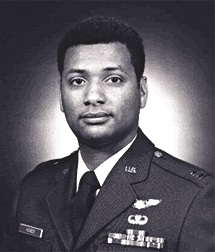 “Lee was one of the nicest individuals you’d ever want to meet, an extremely engaging person,” Mark Seal recalls. “He graduated from the Air Force Academy and continued in the Reserves as a major after leaving active duty. He was very proud of what he had accomplished, and rightly so.”
“Lee was one of the nicest individuals you’d ever want to meet, an extremely engaging person,” Mark Seal recalls. “He graduated from the Air Force Academy and continued in the Reserves as a major after leaving active duty. He was very proud of what he had accomplished, and rightly so.”
“LeRoy and I started out in the military together, flying C-141s out of McGuire,” First Officer Steve Scheri says. “We had a lot of fun memories of being young, bold, and stupid traveling the world together, and just trying to stay out of trouble. Then we were hired together here at United. We had a circle of friends at United, five of us, that was pretty strong.
“LeRoy was truly a gentleman and never had a bad word to say about anything. No matter how bad things looked, he always had a funny line or a quip that made it seem not as bad as we thought. His personality had a positive flow,” Scheri said. “Every time we go to the airport, we know he’s gone, but we also know he’s still with us.”
One of the circle of five is First Officer Marty Hnatov. “He’d always have his hand on the pulse of what was going on,” Hnatov said. His strongest memory of Homer was his ability to live in the present. “LeRoy could always fully enjoy where he was and what he was doing, right then,” he said. “I know I learned to do that from him, because I used to be the other type, always thinking, ‘This isn’t great, there’s gotta be something better.’
“With him I learned that, no, always enjoy today, you don’t know what tomorrow is. It wasn’t until after the initial shock of all that passed that I thought, how amazing, him of all people, because he did fully enjoy every minute up to that point.”
Melodie and LeRoy Homer met through mutual friends, on a long-distance blind date—she lived in California and he in New Jersey. “We spoke on the phone quite a bit,” Melodie said. “Then he flew out to meet me. I went to pick him up from the airport, sight unseen, I hadn’t even seen a picture of him. But we had a connection immediately.” She was working as a nurse, so both were able to coordinate their schedules. “We met in November, and I moved out here in July,” she said.
“He was proud of being nominated to the Air Force Academy, and to both have his military career and be hired by the airline that he wanted to work for. He was working for United when we met, and he was anxious to start the next phase of his life, to get married and have a family. He loved children. He had 10 months with our daughter, Laurel. We were content,” she said.
A few months after 9/11, Melodie Homer and Steve Scheri put their heads together on how to memorialize LeRoy. The result was the LeRoy W. Homer Jr. Foundation.
“We wanted to do something that reflected LeRoy’s journey in aviation,” she said. “He got his private pilot’s license before going to the Air Force Academy, so we decided to support young adults with the same dream to be a career pilot. We have recipients at the Naval and Air Force Academies and in traditional flight programs.”
The scholarship, open to young adults 16–23, funds all flight school expenses for private pilot certification.
“Every time we give out a scholarship, the kids get to learn about him,” Scheri said. “It makes us feel good that they realize that we have lost a very special person. Our intent was to take the negative of 9/11 and make it into something good. Because that’s what he always tried to do.”
The foundation’s website is www.leroywhomerjr.org.

